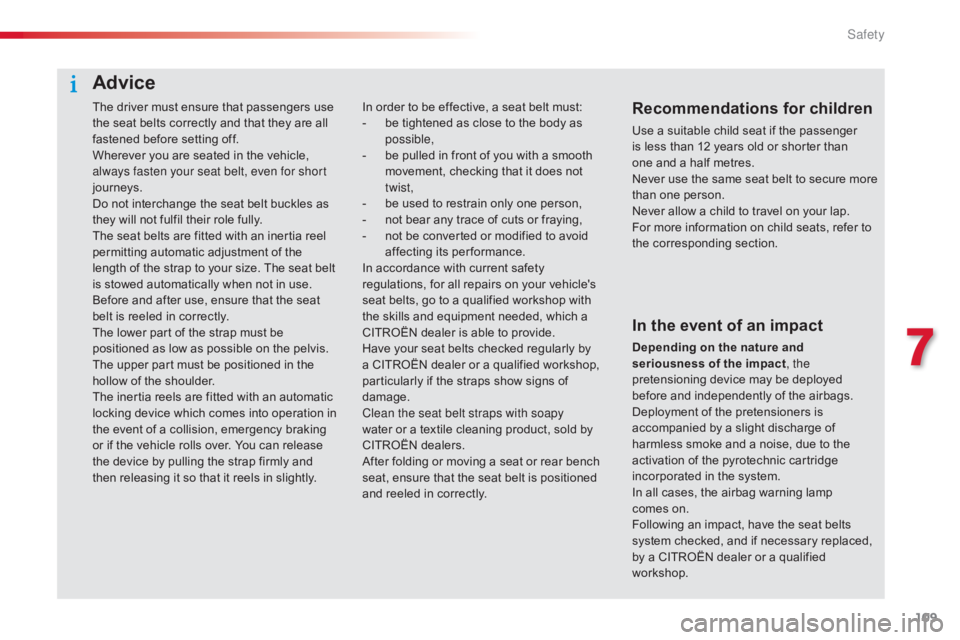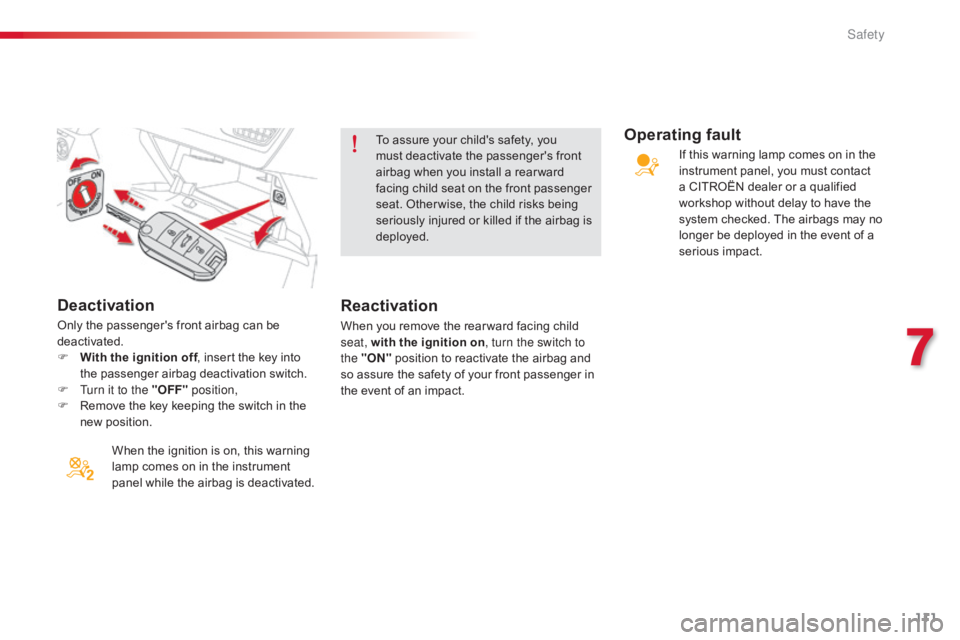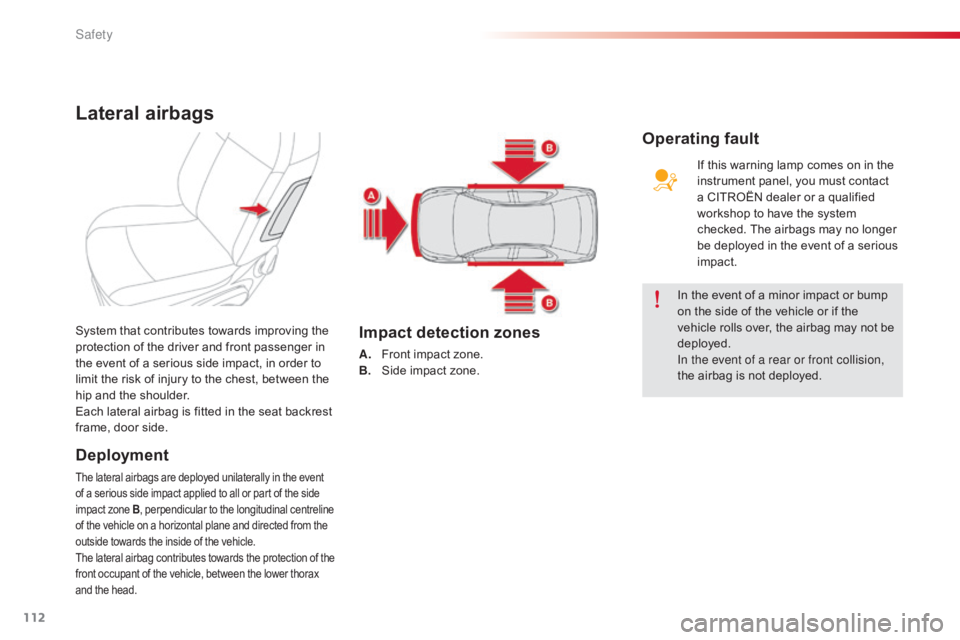warning CITROEN C-ELYSÉE 2016 Service Manual
[x] Cancel search | Manufacturer: CITROEN, Model Year: 2016, Model line: C-ELYSÉE, Model: CITROEN C-ELYSÉE 2016Pages: 260, PDF Size: 7.11 MB
Page 111 of 260

109
C-elysee_en_Chap07_securite_ed01-2016
The driver must ensure that passengers use the seat belts correctly and that they are all
f
astened before setting off.
Wherever
you are seated in the vehicle,
a
lways fasten your seat belt, even for short
journeys.
Do
not interchange the seat belt buckles as
t
hey will not fulfil their role fully.
The
seat belts are fitted with an inertia reel
p
ermitting automatic adjustment of the
l
ength of the strap to your size. The seat belt
i
s stowed automatically when not in use.
Before
and after use, ensure that the seat
b
elt is reeled in correctly.
The
lower part of the strap must be
p
ositioned as low as possible on the pelvis.
The
upper part must be positioned in the
h
ollow of the shoulder.
The
inertia reels are fitted with an automatic
l
ocking device which comes into operation in
t
he event of a collision, emergency braking
o
r if the vehicle rolls over. You can release
t
he device by pulling the strap firmly and
t
hen releasing it so that it reels in slightly.Recommendations for children
Use a suitable child seat if the passenger is less than 12 years old or shorter than
o
ne and a half metres.
Never
use the same seat belt to secure more
t
han one person.
Never
allow a child to travel on your lap.
For
more information on child seats, refer to
t
he corresponding section.
In
order
to
be
effective,
a
seat
belt
must:
-
b
e
tightened
as
close
to
the
body
as
p
ossible,
-
b
e
pulled
in
front
of
you
with
a
smooth
m
ovement,
checking
that
it
does
not
t
wist,
-
b
e
used
to
restrain
only
one
person,
-
n
ot
bear
any
trace
of
cuts
or
fraying,
-
n
ot
be
converted
or
modified
to
avoid
a
ffecting
it
s
p
erformance.
In
accordance
with
current
safety
r
egulations,
for
all
repairs
on
your
vehicle's
s
eat
belts,
go
to
a
qualified
workshop
with
t
he
skills
and
equipment
needed,
which
a
C
ITROËN
dealer
is
able
to
provide.
Have
your
seat
belts
checked
regularly
by
a
CITROËN
dealer
or
a
qualified
workshop,
p
articularly
if
the
straps
show
signs
of
d
amage.
Clean the seat belt straps with soapy
water
or
a
textile
cleaning
product,
sold
by
C
ITROËN
dealers.
After
folding
or
moving
a
seat
or
rear
bench
s
eat,
ensure
that
the
seat
belt
is
positioned
a
nd
reeled
in
correctly.
In the event of an impact
Depending on the nature and
seriousness of the impact , the
pretensioning
device may be deployed
b
efore and independently of the airbags.
D
eployment of the pretensioners is
a
ccompanied by a slight discharge of
h
armless smoke and a noise, due to the
a
ctivation of the pyrotechnic cartridge
i
ncorporated in the system.
In
all cases, the airbag warning lamp
c
omes on.
Following
an impact, have the seat belts
s
ystem checked, and if necessary replaced,
b
y a CITROËN dealer or a qualified
w
orkshop.
Advice
7
Safety
Page 113 of 260

111
C-elysee_en_Chap07_securite_ed01-2016
Deactivation
When the ignition is on, this warning lamp comes on in the instrument
p
anel while the airbag is deactivated.To
assure your child's safety, you
m
ust deactivate the passenger's front
a
irbag when you install a rear ward
f
acing child seat on the front passenger
s
eat. Other wise, the child risks being
s
eriously injured or killed if the airbag is
d
eployed.
Reactivation
Only the passenger's front airbag can be d
eactivated.
F
W
ith the ignition off ,
insert the key into
t
he passenger airbag deactivation switch.
F
T
urn it to the "OFF" position,
F
R
emove the key keeping the switch in the
n
ew position. When
you remove the rear ward facing child
sea
t, with the ignition on, turn the switch to
the "ON"
position to reactivate the airbag and
s
o assure the safety of your front passenger in
t
he event of an impact.
Operating fault
If this warning lamp comes on in the instrument panel, you must contact
a
CITROËN dealer or a qualified
w
orkshop without delay to have the
s
ystem checked. The airbags may no
l
onger be deployed in the event of a
s
erious
im
pact.
7
Safety
Page 114 of 260

112
C-elysee_en_Chap07_securite_ed01-2016
Lateral airbags
Deployment
The lateral airbags are deployed unilaterally in the event of a serious side impact applied to all or part of the side i
mpact zone B,
perpendicular to the longitudinal centreline
o
f the vehicle on a horizontal plane and directed from the
o
utside towards the inside of the vehicle.
The
lateral airbag contributes towards the protection of the
f
ront occupant of the vehicle, between the lower thorax
a
nd the head.
System that contributes towards improving the protection of the driver and front passenger in
t
he event of a serious side impact, in order to
l
imit the risk of injury to the chest, between the
h
ip and the shoulder.
Each
lateral airbag is fitted in the seat backrest
f
rame, door side.Impact detection zones
A. Front impact zone.
B. S ide impact zone. If
this warning lamp comes on in the
i
nstrument panel, you must contact
a
CITROËN dealer or a qualified
w
orkshop to have the system
c
hecked. The airbags may no longer
b
e deployed in the event of a serious
im
pact.
Operating fault
In the event of a minor impact or bump o
n the side of the vehicle or if the
v
ehicle rolls over, the airbag may not be
d
eployed.
In the event of a rear or front collision,
the
airbag is not deployed.
Safety
Page 119 of 260

117
C-elysee_en_Chap08_securite-enfants_ed01-2016
Passenger airbag OFF
Deactivating the passenger's front airbag
Never install a rear ward facing child restraint system on a seat protected by
a
n active front airbag. This could cause
t
he death of the child or serious injury.
For
information on deactivating the
p
assenger's front airbag, refer to the
"
Airbags" section.
The
warning label present on both sides of the p
assenger's sun visor repeats this advice. In
l
ine with current legislation, the following tables
c
ontain this warning in all of the languages
r
equired.
This
label is located on the middle door pillar,
p
assenger
s
ide.
8
Child safety
Page 131 of 260

129
C-elysee_en_Chap09_info-pratiques_ed01-2016
Low fuel level
When the low fuel level in the tank is reached, this warning lamp comes
o
n in the instrument panel.
Opening
the filler cap may result in an
i
nrush of air. This vacuum is entirely
n
ormal and results from the sealing of
t
he fuel system.
Fuel tank
Capacity of the tank: approximately 50 litres.A label on the inside of the filler flap reminds
y
ou of the type of fuel to use according to your
e
ngine.
Additions
of fuel must be of at least 5 litres to
b
e registered by the fuel gauge.
Refuelling
F Open the filler cap by turning it a 1/4 turn to t
he left.
F
R
emove the filler cap and hang it on its
c
arrier (on the filler flap).
F
F
ill the tank. Do not continue past the third
c
ut-off of the nozzle, as this may cause
m
alfunctions.
F
R
efit the filler cap turning it a 1/4 turn to
t
he right.
F
P
ush the filler flap to close it.Opening
F Raise the l ever.
When it first comes on, around 5 litres of fuel
remain in the tank.
You must refuel as soon as possible to avoid
r
unning out.
If you run out of fuel (Diesel), refer the the
"
Checks"
s
ection.
9
Practical information
Page 136 of 260

134
C-elysee_en_Chap09_info-pratiques_ed01-2016
Range indicators
Once the AdBlue® tank is on reserve or after d
etection
of
a
fault with the SCR emissions
c
ontrol
system,
when the ignition is switched
o
n,
an
indicator
displays an estimate of the
d
istance
that
can
be covered, the range, before
e
ngine
starting
is
prevented.
In
the
event
of
simultaneous system fault and
l
ow
AdBlue
® level, the shortest range figure is t
he
one
displayed.
In the event of the risk of non-starting related to a lack of AdBlue®
Range greater than 1 500 miles (2 400 km)
When the ignition is switched on, no
i
nformation on range is displayed automatically
i
n the instrument panel.
Remaining range between 350 and 1500 miles (600 and 2 400 km)
When switching on the ignition, the UREA warning lamp comes on, accompanied by an
a
udible signal and the temporary display in
t
he instrument panel of "NO START IN" and
a
distance, indicating the remaining range
e
xpressed in miles or kilometres before
e
ngine starting is prevented - (For example
"
NO START IN 900 miles" means that "Starting
w
ill be prevented in 900 miles).
When
driving, this display appears every
1
50 miles (300 km) until the additive tank has
be
en
t
opped-up.
Go
to a dealer CITROËN or a qualified
w
orkshop to have the AdBlue
® tank topped-up.
Y
ou
can
also
top-up
the
tank
yourself.
For
more
information
on
topping-up the
Ad
Blue
® additive, refer to the corresponding s
ection.
The
engine
start
prevention
system
r
equired
by
regulations
is
activated
a
utomatically
once
the
AdBlue
® tank is e
m pt y.
Practical information
Page 137 of 260

135
C-elysee_en_Chap09_info-pratiques_ed01-2016
Breakdown related to a lack of AdBlue® additive
When switching on the ignition, the SERVICE w
arning lamp comes on and the UREA
w
arning lamp flashes, accompanied by an
a
udible signal and the temporary display in
t
he instrument panel of "NO START IN" and
0 k
m or miles - ("NO START IN 0 miles" means
"
Starting
p
revented").
The
Ad
Blue
® tank is empty: t he s ystem r equired b
y
regulations prevents engine starting.
Remaining range between 0 and 350 miles (0 and 600 km)
When switching on the ignition, the SERVICE warning lamp comes on and the UREA
w
arning lamp flashes, accompanied by an
a
udible signal and the temporary display in
t
he instrument panel of "NO START IN" and
a
distance indicating the remaining range
e
xpressed in miles or kilometres before
e
ngine starting is prevented - (For example
"
NO START IN 180 miles" means "Starting will
b
e prevented in 180 miles).
When
driving, this display appears every
3
0 seconds until the additive tank has been
t
opped-up.
Go
to a CITROËN dealer or a qualified
w
orkshop to have the AdBlue
® tank topped-up.
Y
ou
can
also
top-up
the
tank
yourself.
Other wise you will not be able to restart your
engine.
For
more
information
on
topping-up the
Ad
Blue
® additive, refer to the corresponding s
ection. To
be able to start the engine,
w
e recommend that you call on
a
CITROËN dealer or a qualified
w
orkshop for the top-up required. If
y
ou carry out the top-up yourself, it is
e
ssential to add at least 3.8 litres of
Ad
Blue
® to the additive tank.
F
or
more information on topping-up
t
he
AdBlue
® additive, refer to the c
orresponding s ection.
9
Practical information
Page 138 of 260

136
C-elysee_en_Chap09_info-pratiques_ed01-2016
Star ting prevented
Every time the ignition is switched on, the
S
ERVICE and engine diagnostic warning
l
amps come on and the UREA warning lamp
f
lashes, accompanied by the temporary display
o
f "NO START IN" and 0 miles or kilometres -
(
"NO START IN 0 miles" means "Starting
p
revented").
To
be able to start the engine, you must call on
a
CITROËN dealer or a qualified workshop.
You
have exceeded the authorised
d
riving limit: the starting prevention
s
ystem inhibits engine starting.
In the event of a fault with the the SCR emissions control system
In the event of the detection
of a fault
The UREA, SERVICE and diagnostic warning
l
amps comes on, accompanied by an audible
s
ignal and the display of the message
"
Emissions
f
ault".
The
alert is triggered when driving, when
t
he fault is detected for the first time, then
w
hen switching on the ignition for subsequent
j
ourneys, while the fault persists.During an authorised driving phase
(between 650 miles and 0 miles) (1 100 km and 0 km)
If a fault with the SCR system is confirmed (after 3 0 miles (50 km) covered with the permanent display o
f the message signalling a fault), the SERVICE
a
nd engine diagnostic warning lamps come on and
t
he UREA warning lamp flashes, accompanied by
a
n audible signal and the temporary display in the
i
nstrument panel of "NO START IN" and a distance,
i
ndicating the remaining range express in miles or
k
ilometres before engine starting is prevented -
(
e.g.: "NO START IN 350 miles" means "Starting will
b
e prevented in 350 miles").
A system that prevents engine starting is activated automatically from 650 miles (1 100 km) after confirmation of a fault with the SCR emissions control system. Have the system checked by a CITROËN dealer or a qualified workshop as soon as possible.
If
it is a temporary fault, the alert
d
isappears during the next journey,
a
fter a self diagnosis test of the SCR
e
missions control system.
While driving, this display appears every 30 seconds while the fault with the SCR system p
ersists.
The
alert is repeated when switching on the ignition.
You
should go to a CITROËN dealer or a qualified
w
orkshop as soon as possible.
Other wise, you will not be able to restart your
engine.
Practical information
Page 139 of 260

137
C-elysee_en_Chap09_info-pratiques_ed01-2016
Freezing of the AdBlue® additive
The
AdBlue
® additive freezes at t
emperatures below around -11°C.
The
SCR
system includes a heater
f
or
the
AdBlue
® tank, allowing you to c
ontinue
driving in very cold conditions.
Topping-up the AdBlue® additive
Precautions in use
Use only AdBlue® additive that meets the
I
SO
22241
standard.
The
supply
in
a
non-drip bottle simplifies
t
opping-up.
You
can obtain 1.89 litre (half a US
g
allon)
bottles
from a CITROËN dealer or a
q
ualified
w
orkshop.
Keep
AdBlue
® out of the reach of
children,
in
its
original bottle.
Never
transfer AdBlue
® to another
container:
it
would
lose
its purity. Never
dilute the additive with water.
Never pour the additive into the Diesel
f
uel tank.
Never top-up from an AdBlue®
dispenser
reserved
for
heavy
goods
v
ehicles.
Filling
the
AdBlue
® tank is an operation i
ncluded
in
every
routine service on your
v
ehicle
by
a
CITROËN dealer or a qualified
w
orkshop.
Nevertheless,
given the capacity of the tank,
i
t
may
be
necessary to top-up the additive
b
etween
services,
more particularly if an alert
(
warning
lamps
and a message) signals the
r
equirement.
You
can
got
to
a
CITROËN dealer or a qualified
w
orkshop.
If
you
envisage
topping-up yourself, please
r
ead
the
following
warnings carefully. The
AdBlue
® additive is an urea-based s
olution.
This liquid is non-flammable,
c
olourless
and odourless (kept in a cool area).
In
the
event
of contact with the skin, wash
t
he
affected
area with soap and water. In the
e
vent
of
contact with the eyes, wash (irrigate)
t
he
eyes
with large amounts of water or with
a
n
eye
wash
solution for at least 15 minutes.
I
f
a
burning
sensation or irritation persists, get
m
edical
attention.
If
swallowed, immediately wash out the mouth
w
ith
clean
water and then drink plenty of water.
In
certain
conditions (high ambient
t
emperature,
for example), the risk of release
o
f
ammonia
cannot be excluded: do not inhale
t
he
product.
Ammonia vapour has an irritant
e
ffect
on
mucous membranes (eyes, nose and
t
hroat).
9
Practical information
Page 146 of 260

144
C-elysee_en_Chap09_info-pratiques_ed01-2016
F Start the compressor by placing the switch a
t the " I"
position and adjust the pressure
t
o the value shown on the vehicle's tyre
p
ressure label.
T
o deflate: press the black button on the
c
ompressor pipe, at the valve connector.
F
O
nce the correct pressure is reached, put
t
he switch to the " O"
position.
F
R
emove the kit then stow it.Should
the pressure of one or more
t
yres be adjusted, it is necessary to
r
einitialise the under-inflation detection
s
ystem.
For
more information on under-inflation
d
etection, refer to the corresponding
s
ection.
Tyre under-inflation
detection
After repair of the tyre, the warning lamp will remain on until the system is
r
einitialised.
For
more information on under-inflation
d
etection, refer to the corresponding
s
ection.
Practical information